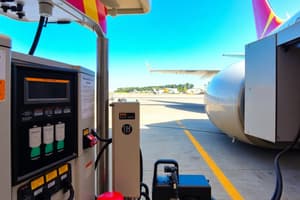Podcast
Questions and Answers
What is the primary purpose of ETOPS fuel?
What is the primary purpose of ETOPS fuel?
- To fulfill regular flight fuel requirements.
- To allow for additional non-critical fuel reserves.
- To ensure diversion fuel requirements are met. (correct)
- To reduce overall fuel consumption during flight.
When is SDTO fuel required to be boarded?
When is SDTO fuel required to be boarded?
- When operational conditions necessitate additional fuel.
- To ensure planned flight fuel for SDTO route segments is sufficient. (correct)
- For any flight exceeding 60 minutes flying time.
- For all flights over designated airports.
How does LIDO assess available CONT fuel at the ETOPS critical point?
How does LIDO assess available CONT fuel at the ETOPS critical point?
- It assumes no CONT fuel will be available.
- It assumes 1/4 of CONT fuel is available for diversion purposes. (correct)
- It assumes that half of CONT fuel will be available.
- It assumes all CONT fuel will be available.
What altitude must be maintained above an airport during holding for SDTO fuel?
What altitude must be maintained above an airport during holding for SDTO fuel?
What does ETOPS fuel become available for after the ETOPS exit point?
What does ETOPS fuel become available for after the ETOPS exit point?
What defines an adequate airport for SDTO route segments?
What defines an adequate airport for SDTO route segments?
Which of the following is true regarding Extra fuels?
Which of the following is true regarding Extra fuels?
What is the purpose of the Tanker (TKG) fuel?
What is the purpose of the Tanker (TKG) fuel?
What does MIN T/O FUEL exclude?
What does MIN T/O FUEL exclude?
Which document is used primarily for monitoring fuel status during a flight?
Which document is used primarily for monitoring fuel status during a flight?
What should the Flight Crew do if actual fuel consumption exceeds the planned consumption indicated in the OFP?
What should the Flight Crew do if actual fuel consumption exceeds the planned consumption indicated in the OFP?
When should Flight Crew engage Dispatch regarding a change in the fuel plan?
When should Flight Crew engage Dispatch regarding a change in the fuel plan?
What is indicated if the AFOB is less than the MFOB at an OFP waypoint after Top of Climb?
What is indicated if the AFOB is less than the MFOB at an OFP waypoint after Top of Climb?
What should occur prior to take-off regarding fuel?
What should occur prior to take-off regarding fuel?
What should be done if a fuel leak is suspected during flight?
What should be done if a fuel leak is suspected during flight?
Why is proactive communication with Dispatch important?
Why is proactive communication with Dispatch important?
What should be done if anticipated block fuel is less than required at the start of pushback?
What should be done if anticipated block fuel is less than required at the start of pushback?
Under what condition can pilots push back the aircraft without Extra fuels?
Under what condition can pilots push back the aircraft without Extra fuels?
What should a crew do if all additional fuels are consumed during an extended ground delay?
What should a crew do if all additional fuels are consumed during an extended ground delay?
When should Dispatch be advised of potential delays affecting landing?
When should Dispatch be advised of potential delays affecting landing?
What must not be permitted prior to take-off regarding fuel levels?
What must not be permitted prior to take-off regarding fuel levels?
What is the preferred method for sending revised parts of the OFP to the aircraft?
What is the preferred method for sending revised parts of the OFP to the aircraft?
What should the crew consider if they anticipate delays due to ATC?
What should the crew consider if they anticipate delays due to ATC?
What is the implication of the phrase 'Stop short of destination' in the context of flight operations?
What is the implication of the phrase 'Stop short of destination' in the context of flight operations?
What should the Pilot-in-Command and Flight Dispatcher ensure before take-off in relation to fuel?
What should the Pilot-in-Command and Flight Dispatcher ensure before take-off in relation to fuel?
What action is required if less than MIN T/O FUEL is anticipated before take-off?
What action is required if less than MIN T/O FUEL is anticipated before take-off?
When is a take-off alternate required?
When is a take-off alternate required?
What happens if the AFOB falls below the MFOB after reaching Top of Climb?
What happens if the AFOB falls below the MFOB after reaching Top of Climb?
Which of the following is NOT a condition under which a take-off alternate is required?
Which of the following is NOT a condition under which a take-off alternate is required?
Under what condition may ALTN Fuel be consumed without proceeding to an alternate airport?
Under what condition may ALTN Fuel be consumed without proceeding to an alternate airport?
Which factor does NOT need to be considered by the Pilot-in-Command when deciding to consume ALTN Fuel?
Which factor does NOT need to be considered by the Pilot-in-Command when deciding to consume ALTN Fuel?
What must be done whenever any portion of ALTN Fuel is consumed without proceeding to an alternate?
What must be done whenever any portion of ALTN Fuel is consumed without proceeding to an alternate?
What is the primary purpose of Contingency Fuel (CONT)?
What is the primary purpose of Contingency Fuel (CONT)?
In which scenario is BURN Fuel primarily calculated?
In which scenario is BURN Fuel primarily calculated?
What should be done if actual fuel burn is significantly greater than the planned burn?
What should be done if actual fuel burn is significantly greater than the planned burn?
Why does Air Canada apply a consistent Contingency Fuel Policy for all operations, according to their practices?
Why does Air Canada apply a consistent Contingency Fuel Policy for all operations, according to their practices?
What should NOT be included when planning fuel requirements for flights?
What should NOT be included when planning fuel requirements for flights?
Study Notes
Fuel Consumption and Planning
- If additional or contingency fuel is used on the ground, the Pilot-in-Command (PIC) and Flight Dispatcher must ensure sufficient fuel remains for a safe flight, accounting for weather, ATC, and other potential delays.
- If ground communication with Dispatch is delayed, the PIC must inform Dispatch once airborne.
- Take-off is prohibited if onboard fuel is below the planned minimum take-off fuel (MIN T/O FUEL). A new OFP must be generated if MIN T/O FUEL is anticipated to be less than planned.
- After Top of Climb, if available fuel onboard (AFOB) is less than minimum fuel onboard (MFOB) at an OFP waypoint, a revised fuel plan must be coordinated with Dispatch.
Take-Off Alternates
- A take-off alternate is required if take-off visibility is below RVR 2600 or 1/2 statute mile, or if reported weather is below landing minima preventing immediate return to the departure airport. CAT II or CAT III limits are not considered when determining these minima.
- Dispatch may also mandate a take-off alternate for other operational reasons.
- Alternate fuel (ALTN) may be used without going to the alternate airport if the PIC judges a safe landing at the destination is possible. Factors to consider include runway availability, weather, traffic congestion, and other potential landing delays at both airports.
- Routine ALTN fuel consumption is prohibited. Dispatchers and PICs should not plan to use ALTN fuel. If used, Dispatch must be notified, and an Air Safety Report (ASR) filed.
Fuel Types and Their Uses
- Burn (BURN) Fuel: Calculated for travel from take-off to destination, considering the planned route and vertical profile; An ASR should be filed if actual burn significantly exceeds planned burn.
- Contingency Fuel (CONT): Compensates for unforeseen factors; applied to all flights (domestic and international) by Air Canada, even though only required internationally by regulations.
- Extended-range Twin-engine Operations (ETOPS) Fuel: Ensures ETOPS route segment diversion fuel requirements are met; not always necessary for ETOPS flights; LIDO flight planning considers CONT fuel availability at the ETOPS critical point. Available for other uses after the ETOPS exit point.
- Standard Diversion Time Operations (SDTO) Fuel: Ensures sufficient fuel for a diversion within 60 minutes to an adequate airport; includes descent, cruise at one-engine-inoperative service ceiling or 10,000 feet ASL, approach, missed approach, and 30-minute hold.
- Extra Fuels (TKG, OPN, XFOB): Not regulatory; consumed operationally as needed. Includes Tanker fuel (TKG) and other operational fuels. MIN T/O FUEL does not include fuel for weather or ATC delays.
Fuel Plan Monitoring and Communication
- The OFP is the primary fuel monitoring tool. Operational participants must monitor planned versus actual fuel use. Comparing AFOB to MFOB/EFOB at waypoints validates the OFP.
- If fuel consumption exceeds the plan, action is required to protect safety and flight integrity. At least MIN T/O FUEL must be on board before take-off.
- Suspected fuel leaks require following QRH procedures.
- Flight crew should coordinate with Dispatch regarding any situation potentially altering the fuel plan.
- Examples include less than block fuel at pushback, less than flight fuel at take-off, or AFOB < MFOB after Top of Climb. Refer to section 12.7.2 for low fuel situations.
Pre-Flight and Post-Pushback Fuel Considerations
- If less than block fuel is anticipated at pushback, a revised fuel plan and/or refueling should be considered. If timely Dispatch contact is impossible, pushback is permitted without extra and some additional fuels if the PIC deems remaining fuel sufficient. Foreseeable delays must be accounted for, and Dispatch should be informed promptly.
- If less than flight fuel is anticipated at take-off, a revised fuel plan should be considered.
- Some CONT fuel may be used on the ground after pushback if additional fuels are consumed during a lengthy ground delay.
- Flights cannot depart with less than MIN T/O FUEL.
Studying That Suits You
Use AI to generate personalized quizzes and flashcards to suit your learning preferences.
Related Documents
Description
This quiz covers essential concepts of fuel consumption and planning in aviation, including communication protocols between the Pilot-in-Command and Dispatch. Additionally, it addresses requirements for take-off alternates based on visibility and weather conditions, ensuring safe operational practices.




